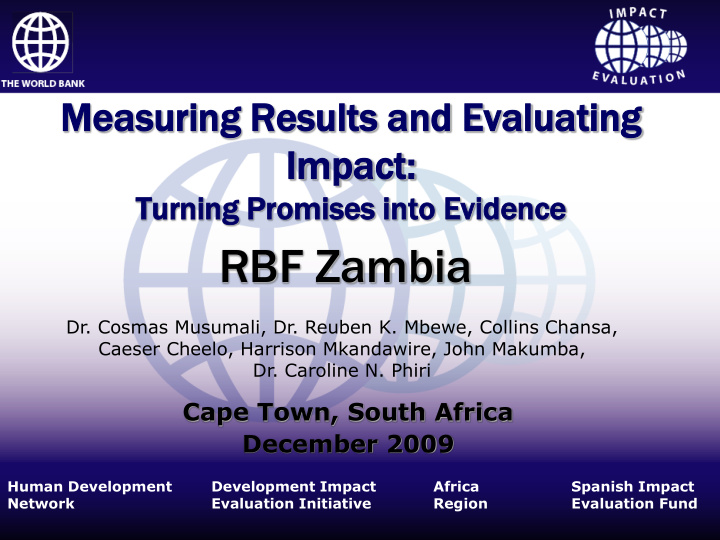



Measur suring ing Result lts s and nd Evalu luating ating Impa pact: t: Turn rnin ing g Promise ises s in into Evid idence ence RBF Zambia Dr. Cosmas Musumali, Dr. Reuben K. Mbewe, Collins Chansa, Caeser Cheelo, Harrison Mkandawire, John Makumba, Dr. Caroline N. Phiri Cape Town, South Africa December 2009 Human Development Development Impact Africa Spanish Impact Network Evaluation Initiative Region Evaluation Fund
2
Background … Population: 12.2 million (2007 proj.) Under-5 mortality rate: 119 per 1,000 live births Infant mortality rate 70 per 1,000 live births Maternal Mortality: 591 per 100,000 Poverty incidence: 64 percent Gini-coefficient: 0.57 3
1. Background …. HRBF Pilot to assess if incentives and related investments improve service delivery outcome To inform policy on mode of funding of Health sector 6 MCH indicators paid on fee for service quality adjusted basis 4
2. Results Chain Inputs Activities Outputs Outcomes Longterm Outcomes • Reduced Neonatal • Trust Fund • Quarterly • Increased • Increased rates mortality, U5MR, financing assessment of financing of: in-facility MMR quality adjusted through deliveries, PNC, • MoH and services and incentive immunization • Improved consultant payout payments coverage, ANC, nutritional status technical contraceptive of women and support • Investments in • Facilities uptake, ITN children - higher facility upgraded: MCH usage productivity, infrastructure and equipment and better cognitive staff capacity supplies, water • Increased development, etc. reticulation quality of MCH • 3 rd party services • Woman able to audit/verification • Capacity attain ideal family of self-reported building: HW • Increased size indicators trained, capacity of DHMT systems strengthened 5
3. Primary Research Questions What is the causal effect of the Zambian HRBF on the health services outcomes of the interest? Do higher incentive payments in rural/remote areas result in increased health outcomes and greater retention of staff How does the likelihood of audit/external verification of results affect the accuracy of reported data? 6
4. Outcome Indicators Institutional deliveries by skilled birth attendant Postnatal visits within 6 days of delivery by health centre staff (delivery at home or in facility Full immunization coverage of children under 1 Pregnant women receiving at least 2 doses of IPT 7
4. Outcome Indicators Women (ages 15 -49) or partners using any type of contraception (new acceptors) Women receiving iron supplements at antenatal care Community outcome indicators to be finalized Non-incentivized outcome indicators also tracked 8
5. Identification Strategy/Method Question 1: Three districts per province matched and randomized across: Equipment, commodities, financing and incentives Equipment, commodities and financing “Business as usual” Facilities then matched across treatments arms and dif-in-dif strategy Question 2: Incentive levels randomized across remote/rural facilities within selected districts Question 3: Audit frequency and method randomized across facilities within selected 9 districts
6. Sample and data Administrative data (HMIS, etc.) – on- going and continuos Household survey data – baseline and follow-up (24 months follow-up) of 3000 households mínimum Facility survey data – baseline and follow- up of 200 facilites mínimum Qualitative interviews with health staff, community External audit data – at minimum twice yearly 10
7. Time Frame/Work Plan On-going pre-pilot in 1 district (1 year) Pilot-project for 9 districts extends to three years begining in June 2010 Draft design and PIM already in place Currently fine-tuning and designing community component, quality tools Evaluation design drafted and currently revising cost analysis and cost data collection, qualitative evaluation design 11
8. Sources of Financing Norwagian Trust Fund: USD$ 11 million MoH support: Staff time and logistics, infrastructure World Bank preparatory grant and Impact Evaluation Trust Fund 12
Recommend
More recommend